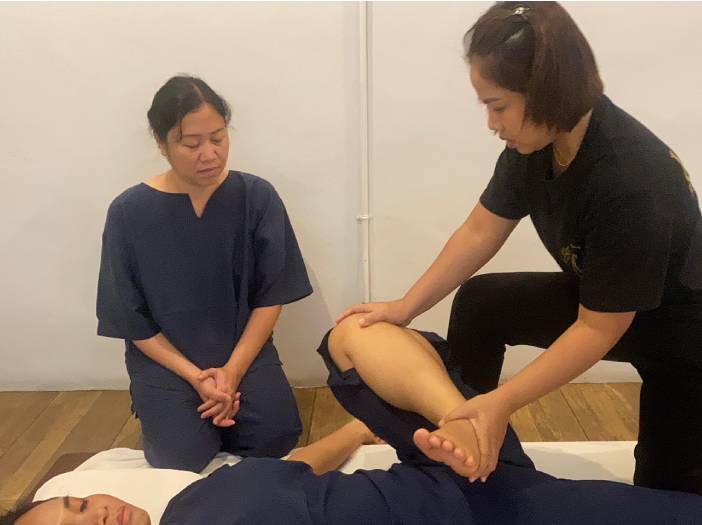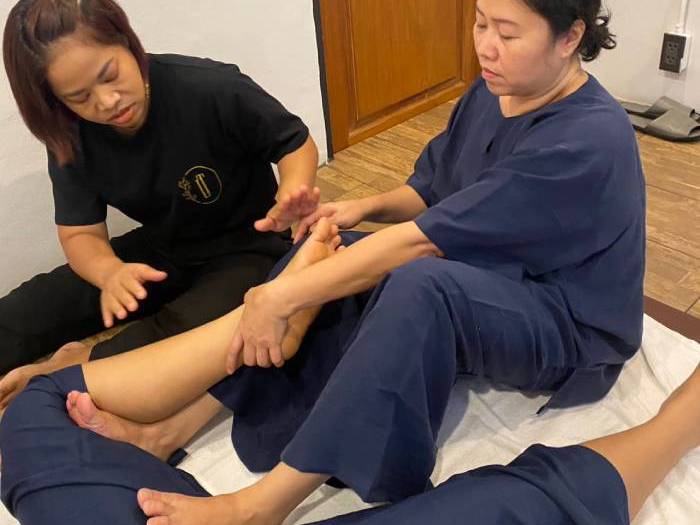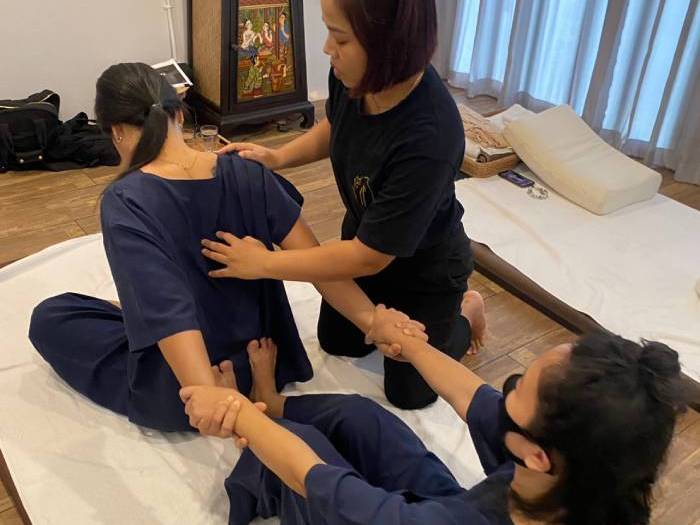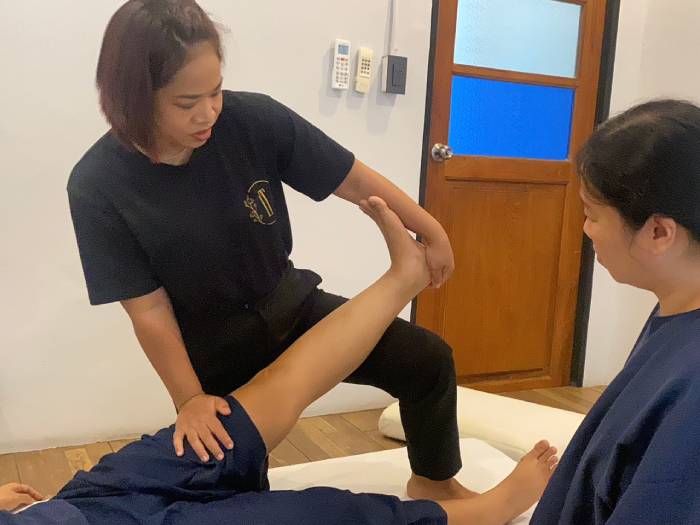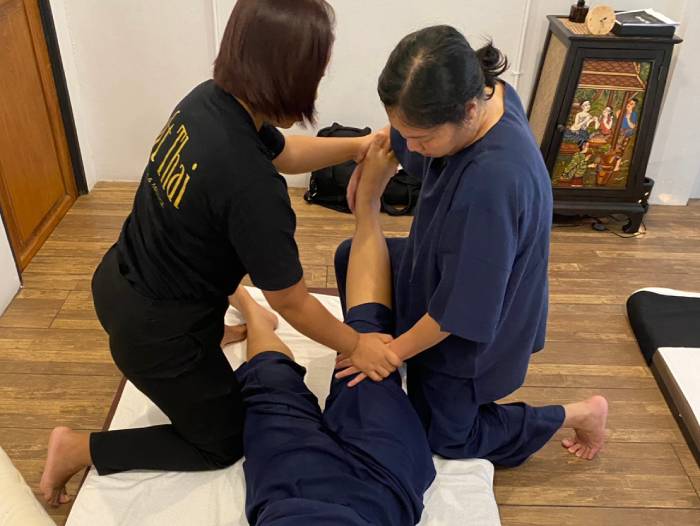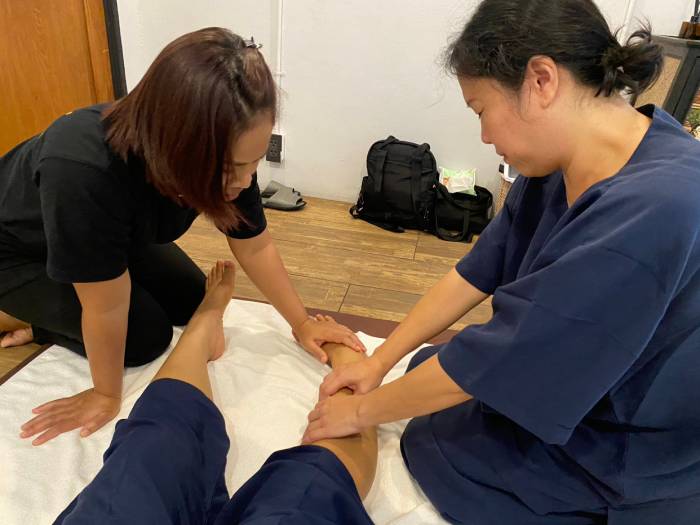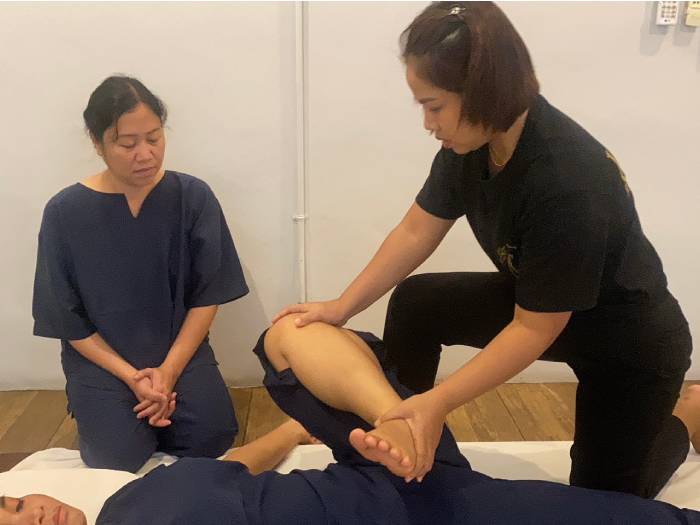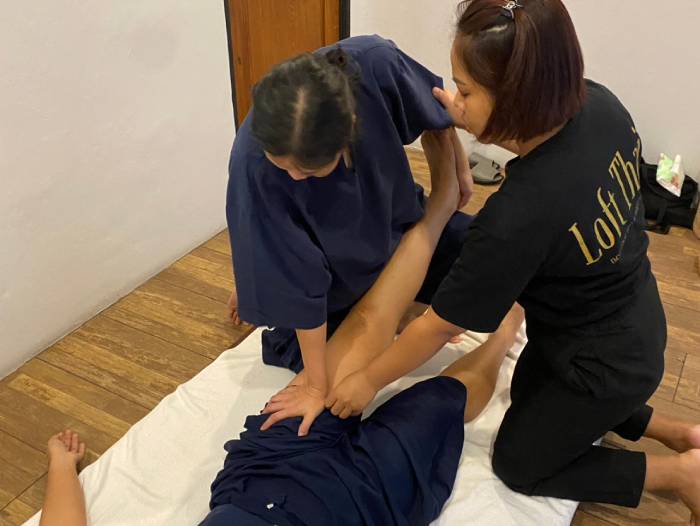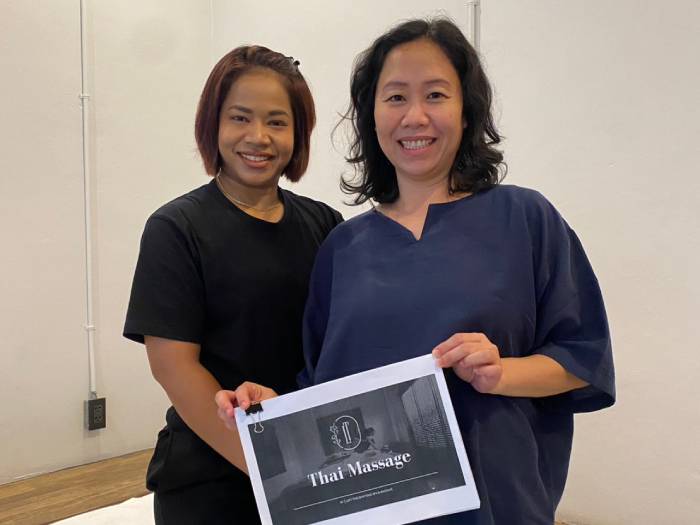Thai Massage Course in Bangkok
Bangkok, Thailand’s vibrant capital, is a city of fascinating contrasts. Towering skyscrapers loom over ancient Buddhist temples, while modern shopping complexes sit alongside bustling local markets. At every turn, you discover a piece of history, a taste of local culture, or an immersive sensory experience that perfectly illustrates how tradition and modernity can coexist. This city is the birthplace of numerous Thai cultural treasures, including the world-renowned tradition of Thai massage. With its warm climate, thriving tourism sector, and internationally acclaimed street food, Bangkok provides an immersive backdrop for those who come to learn about the healing arts. There is an undeniable energy in this city that makes it a natural home for an intensive, authentic training program in Thai Massage.
Location: Sukhumvit
Our massage school is located in Sukhumvit, one of Bangkok’s most cosmopolitan and dynamic districts. Sukhumvit Road is considered one of the longest boulevards in the world, extending from central Bangkok all the way to the borders of neighboring provinces. Teeming with life day and night, Sukhumvit boasts upscale shopping malls, an eclectic dining scene, lively nightlife, and a blend of expatriates and local Thai residents. Despite its modern veneer, you can still find small pockets of traditional Thai culture hidden among its narrow streets and cozy neighborhoods. This juxtaposition of the traditional and the contemporary makes Sukhumvit an engaging environment in which to study Thai Massage. Students will find easy access to public transportation, including the BTS Skytrain, making travel in and out of the area quick and efficient. Cafés, restaurants, and local eateries are plentiful, offering the perfect spot for a snack or meal in between study sessions or after a full day of hands-on training. Beyond convenience, the neighborhood itself is a testament to Bangkok’s continuous evolution, reflecting a melding of cultures that parallels the broad appeal of Thai Massage for people from all walks of life.
Origins of Thai Massage
Thai Massage, known in Thailand as “Nuad Thai,” traces its roots back more than two and a half millennia. According to popular belief, its founding father was Jivaka Kumar Bhaccha, an ancient physician who is said to have been a contemporary of the Buddha. Over the centuries, Thai Massage has been influenced by various systems of medicine, including Indian Ayurveda, traditional Chinese medicine, and local Thai healing traditions. For centuries, Thai Massage was practiced almost exclusively in temples, passed down through oral tradition from master to student. Today, it has adapted to modern contexts, but it still retains many of its ancient techniques and spiritual philosophy that place emphasis on compassion, mindfulness, and respect for both the practitioner and the recipient. Studying Thai Massage in Bangkok, the heartland of the tradition, grants students direct exposure to these historical and cultural roots, providing a more profound understanding and deeper appreciation for the practice.
Philosophy and Principles
The philosophy of Thai Massage revolves around the idea of energy lines, commonly called the “Sen” lines in Thai. According to Thai belief, life force energy flows through these channels throughout the human body. When these channels become obstructed, discomfort or imbalance may arise. Thai Massage seeks to release blockages in these energy pathways through gentle or firm pressure, rhythmic rocking, and assisted yoga-like stretches. The goal is not only the relaxation of muscles but the realignment of the entire mind-body system. This holistic nature of Thai Massage encourages practitioners to be fully present, applying compassion and focused attention to the recipient, thus cultivating a deeper, more mindful approach to well-being. The course at our school underscores these philosophical elements, ensuring that students appreciate the work not merely as physical manipulation but as a holistic healing art.
Introduction to the Course and What to Expect
Our Thai Massage course is designed to accommodate individuals with varying levels of experience. Absolute beginners are welcome, as the training is structured to lay a robust foundation in the fundamental techniques, body mechanics, and core principles. At the same time, those with prior experience in massage or related fields, such as yoga or physical therapy, will find opportunities to refine their skills, explore advanced variations, and deepen their theoretical knowledge. From the very first day, students can expect a combination of theoretical lessons, hands-on practice, and reflective discussions that tie technique to the broader cultural and spiritual significance of Thai Massage.
Preparation for each lesson involves attire suitable for movement, as Thai Massage is performed on a mat on the floor, typically with both the practitioner and the recipient dressed in comfortable, loose-fitting clothing. Students must be ready to kneel, squat, bend, and stretch, and thus we recommend clothing similar to yoga wear, which allows for the full range of motion. Our school provides all necessary materials, including mats and manuals. We also maintain a tranquil, climate-controlled training room to ensure a comfortable and focused learning environment.
A Day in Training: Flow and Process
A typical training day begins with a short mindfulness or meditation session. This step is essential to help students become centered, grounded, and mentally prepared for the day’s activities. Many practitioners believe that the state of mind of the therapist has a direct impact on the quality of healing transmitted during Thai Massage.
Short lectures and demonstrations follow, where instructors explain the techniques, relevant Sen lines, and anatomical details. Students then practice in pairs, receiving real-time feedback. The emphasis is on mastering the subtleties of touch rather than performing rote sequences.
By mid-day, students take a lunch break, after which training resumes with hands-on practice, advanced stretches, and new body regions. The day concludes with a reflective discussion, reinforcing continuous learning and self-awareness.
Detailed Steps and Techniques
The training begins with foundational movements such as gentle rocking and palming. Students gradually learn deeper techniques, including thumb pressure, tissue work, and assisted stretches.
Training Positions:
- Supine Position: Techniques for feet, legs, abdomen, arms, and neck, focusing on Sen lines.
- Side-Lying Position: Used for deeper work on hips and shoulders, beneficial for special populations.
- Prone Position: Focuses on the back, shoulders, and legs, relieving accumulated tension.
- Seated Position: Neck, shoulder, and upper back work, often concluding a session.
Throughout the course, students develop sensitivity to energy wind gates, adapting pressure and technique for individual needs.
Course Content and Step-by-Step Learning
- Introduction to Thai Massage Philosophy and Energy Lines: Understanding Sen lines and energy flow.
- Body Positioning and Therapist Ergonomics: Safe body mechanics and posture awareness.
- Supine Position Techniques: Foot massage, leg stretches, hip opening, and upper body work.
- Side-Lying Position Techniques: Techniques for pregnant clients, elderly individuals, and mobility-challenged persons.
- Prone Position Techniques: Focused work on the back, spine, shoulders, and hamstrings.
- Seated Position Techniques: Neck, shoulders, and chest opening to balance energy.
- Full Body Routine Integration: Structuring a professional 60-90 minute Thai Massage session.
Students develop confidence through hands-on practice, ensuring they can provide a well-structured and adaptive massage experience.
Recommendations, Self-Care, and Mind-Body Connection
Students are advised to maintain their own self-care regimen during the course. Thai Massage can be physically demanding, and good self-care helps prevent fatigue or strain. Techniques for self-massage, stretching, and mindful breathing are shared to keep the body limber and the mind clear. It is also recommended to maintain a healthy, balanced diet, stay well hydrated, and ensure enough rest. Mental clarity is paramount, as it facilitates more empathetic and sensitive interaction with the recipient.
Our school particularly encourages the integration of meditation or mindfulness practices into daily life. Because Thai Massage is steeped in the spiritual traditions of Buddhism and Thai healing culture, cultivating a mindset of compassion and presence greatly enhances the quality of touch and the overall therapeutic effect of each session. Students often report that by the end of the course, they not only gain a new skill set, but also develop a greater sense of peace and connectivity in their personal lives.
Benefits and Outcomes
Upon completion, students are equipped with the knowledge and skill to perform a full-body Thai Massage session that typically ranges from 60 to 120 minutes. These newly acquired abilities can be applied in numerous ways. Some students choose to incorporate Thai Massage into an existing holistic or spa practice, enhancing the variety of treatments they offer. Others choose to work as freelance therapists, bringing the benefits of Thai Massage to a wide array of clients seeking relief from stress, muscular tension, or energy imbalances. Many students find that the mindful, meditative nature of Thai Massage helps them foster deeper connections with clients and fosters a strong reputation in the wellness community.
Furthermore, proficiency in Thai Massage can open doors in international wellness resorts, cruise ships, and high-end spas. The global fascination with Thailand and its healing traditions means that Thai Massage practitioners are in steady demand in numerous countries. Beyond professional advancement, many people study Thai Massage to enhance their personal relationships, learning how to offer meaningful touch to family and friends. Even a brief introduction of Thai Massage techniques can significantly elevate one’s ability to handle tension, promote relaxation, and share the gift of healing through touch.
Continuation of Learning and Further Specialization
For students who wish to delve deeper, the study of Thai Massage need not stop at this foundational course. We offer advanced modules in areas such as herbal compress therapy, Thai reflexology, and specialized sequences for particular ailments like office syndrome or sports-related strains. Some schools also teach the “Tok Sen” technique, an ancient form of Thai bodywork using wooden tools to vibrate and release deep blockages. As with any healing modality, continued education can help refine one’s expertise, allowing for a highly specialized or holistic practice that addresses a wide range of client needs.
Advanced training often entails a more nuanced look at anatomy, focusing on how muscles, joints, and connective tissues respond to different types of pressure and stretching. With experience, practitioners also become adept at reading a client’s body, identifying areas of tension or misalignment, and customizing sessions to yield the greatest therapeutic benefit. This level of skill often involves a profound sense of intuitive awareness, which is cultivated over time through dedicated practice and reflection.
Practical Considerations and Certification
While our course covers in-depth techniques, theory, and practice, it also addresses practical considerations such as client consultation, professional ethics, and the creation of a safe, welcoming treatment space. Students learn how to screen for contraindications, adapt their approach for different body types and conditions, and communicate effectively to ensure the comfort and trust of their clients. These aspects of client handling are integral components of a professional Thai Massage practice.
Upon successful completion, students receive a certificate from our school acknowledging their training in Traditional Thai Massage. This certification is recognized by local wellness communities and can be valuable for those seeking employment in Thailand or abroad, although students are advised to check the licensing requirements of their home countries or desired work locations. The certificate represents a milestone in the journey to mastering Thai Massage, but true mastery is a lifelong process of practice, growth, and ongoing learning.
What You Can Do After This Course
After completing the training, numerous pathways become available. Some graduates choose to work as in-house therapists at spas and wellness centers. Others opt for a more independent route, offering mobile services or opening their own private studio. In places where licensing requirements are met, Thai Massage can be combined with other modalities such as Swedish massage, deep tissue work, or aromatherapy, providing a more diversified skill set for a holistic practice. If you enjoy teaching and have acquired significant experience, there are also opportunities to become an instructor, helping to perpetuate and evolve this ancient tradition.
A significant number of students take this course purely out of personal interest, seeking to enhance their personal well-being and share the benefits of Thai Massage with loved ones. They find that the course helps them to better understand and manage stress, cultivate empathy, and refine their own body awareness. Even if one’s goal is not to pursue a professional career, the process of learning Thai Massage often brings lasting benefits that extend far beyond the classroom, enriching physical, emotional, and mental health.
A Note on the Sukhumvit Lifestyle
Because our facility is located in Sukhumvit, students have the advantage of experiencing a portion of Bangkok that is accessible, diverse, and full of life. Sukhumvit effortlessly meshes traditional Thai culture with a modern urban lifestyle. During training breaks or off-days, students might explore the nearby cafés that serve fusion cuisine, sample authentic street food from local vendors, or visit well-known shopping centers such as Terminal 21 or EmQuartier. In the evenings, the area comes alive with international restaurants, trendy bars, and cultural performances. Although the training itself can be intensive, Sukhumvit offers plenty of options for relaxation and enjoyment once the day’s lessons are done. There is also a wealth of Thai cultural landmarks accessible by train or taxi, giving students the opportunity to enrich their stay in Bangkok with sightseeing or cultural immersion.
Embracing Cultural Sensitivity
Thai Massage is intertwined with Thai culture, and our course encourages respectful engagement with local customs and traditions. Students often find they gain a deeper appreciation for Thai cuisine, language, and etiquette as they progress through the training. By studying the cultural context in which Thai Massage developed, one learns not only the physical techniques but also the deeper spiritual and communal values that make this art form truly unique.
Conclusion
The content provided here serves as a general guideline and source of information regarding our Thai Massage training program. It outlines a broad framework that typically remains consistent, including the philosophical underpinnings, skill progression, and emphasis on holistic well-being. However, please note that exact course content and structure may vary based on several factors, including the instructor’s lineage, the background and needs of each student group, evolving best practices in the wellness industry, and real-time feedback from participants. Our instructors frequently tailor their approach to address specific student questions, prior professional experience, or areas of particular interest. If you have specialized requirements, physical constraints, or a distinct focus—such as advanced therapy for specific conditions—please communicate these preferences in advance so we can adapt the training accordingly.
We are committed to delivering a rigorous, supportive, and enlightening learning experience for every participant, while remaining flexible enough to accommodate different learning speeds and objectives. By acknowledging that each person’s journey is unique, we create a more inclusive atmosphere that respects individual differences, fosters curiosity, and upholds the spirit of compassion and mindfulness that is integral to Thai Massage.
Whether you intend to pursue a professional career in the wellness sector or simply wish to enrich your personal life with this healing art, our Thai Massage course offers a comprehensive, culturally immersive, and deeply fulfilling educational experience in the heart of Bangkok. We look forward to supporting you on this journey of discovery and skill development, and we stand ready to answer any questions, address concerns, or provide further guidance as you prepare to begin this transformative path.
If you would like to experience the Thai Massage performed by a professional therapist, we highly recommend booking a session with our partner Loft Thai Boutique Spa & Massage. Their experienced team offers authentic treatments in a serene and luxurious setting. To explore and book your session, please visit the link below. All students from Nuad Thai School are entitled to an exclusive 20% discount on all treatments.
Pricing
Packages made for anyone!
Thai Discover
- 4-hours group course
- Instructor & Model
- Introduction & Theory
- Thai Massage Practice
- School Certification
Thai Beginner
- 4-hours private course
- Instructor & Model
- Introduction & Theory
- Thai Massage Practice
- School Certification
Thai Professional
- 150 hours private course
- Instructor & Model
- Professional Training Course
- Custom or Tailor-Made
- Official THAI UTTS Certification

